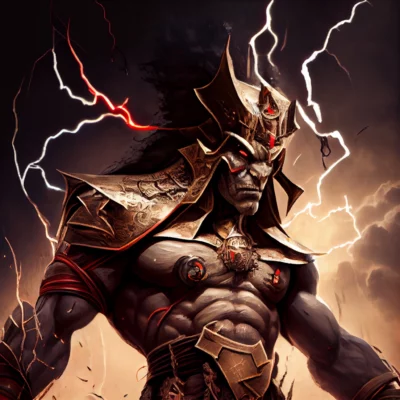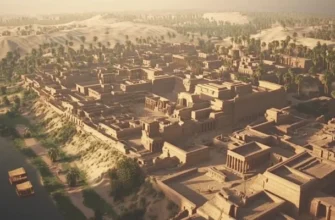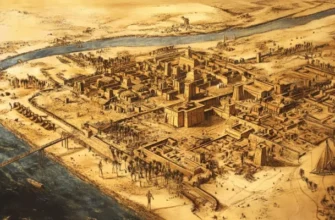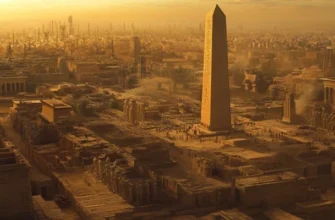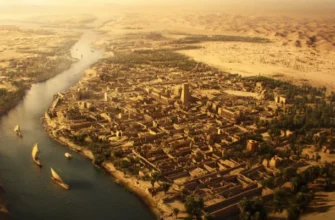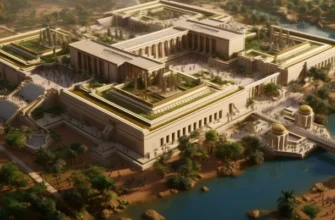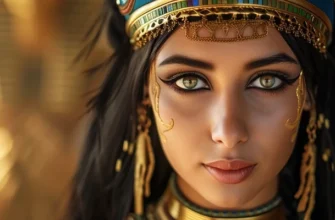The Egyptian god Set is one of the most complex and controversial gods of Egyptian mythology. He was the god of storm, chaos, and evil, as well as the protector of the desert and desert roads. His symbols were lightning, thunder, sand, and storm, and he himself was depicted with the face of a dog or hyena. Seth was an opponent of Osiris, the god of earth and fertility, and killed him, but was then defeated by Isis and Horus. Despite this, Seth was a fairly common god, especially among warriors and deserters, who considered him the protector of the desert and desert paths. The cult of Set was quite widespread in ancient Egypt, and modern culture uses symbolism of Set in literature, film, and art.
- Description of the appearance and character of the god Seth
- History and symbolism
- The role of Seth in Egyptian mythology
- God of storm and chaos
- The protector of the desert and desert roads
- The cult of Set
- Seth in contemporary culture
- Seth in literature and movies
- Using the symbolism of Set in contemporary art
- Conclusion
Description of the appearance and character of the god Seth
The appearance and character of the god Seth were quite complex and controversial. He was usually depicted with the face of a dog or hyena, the head of a crocodile, and other animals. He also had color symbolism – red and black symbolized war and chaos.
The character of the god Seth was also very controversial. On the one hand, he was the god of storm and chaos, which caused fear and terror among people. On the other hand, he was the protector of the desert and desert paths, which made him popular among warriors and deserters.
It is also known that Seth was an opponent of Osiris, the god of earth and fertility, and killed him. This made Seth the most hated god among the Egyptians. However, later Isis and Horus were able to defeat Seth and bring Osiris back to life.
History and symbolism
The history of the god Set goes back to the ancient times of Egypt, when he was the god of storm and chaos. He was often depicted with weapons and assassins that symbolized his power and cruelty.
In the main city of Egypt, Heliopolis, the god Set was associated with the sun and the deity Ra. He was known as the protector of the Sun God and his boat from evil forces.
The symbolism of the god Set includes many animal symbols, including a hyena, crocodile, dog, and scorpion. His symbols were also Tefnut and Isis, which reflected his power over the desert and desert paths.
In addition, his symbol was the griffin, which was a creation from his head and wings, and symbolized his power over the air and sky.
In Egyptian culture, the god Seth was initially worshipped as a god of storm and chaos, but over time his image became associated with evil and betrayal. Therefore, later on, many gods and pharaohs tried to ban the worship of Set and replace him with another god. However, to this day, his cult still exists in some places in Egypt, and his symbolism remains one of the most recognizable and popular among many cultures.
The role of Seth in Egyptian mythology
The god Seth played an important role in Egyptian mythology. He was one of the most defining gods, playing an important role in the creation of the world and the battles between the gods.
According to the myths, Seth was one of the children of the god Geb and the goddess Nut. He was the brother of Osiris, Isis and Nephthys. Osiris was designated as the father of the generation born after the creation of the world, while Seth was designated as the killer brother who was in disputes and struggles with Osiris.
In the myths of Osiris and Seth, Seth killed Osiris and dismembered his body into 14 parts, scattering them around the world. Isis collected her husband’s body parts and restored his life, while Seth became a symbol of evil and betrayal.
Seth was also considered the patron saint of the pharaohs and was often depicted on Egyptian temples. His symbolism reflected power over and struggle against evil forces. He was also often associated with destruction and rebirth, as a symbol of a new beginning.
All of these aspects of the role of the god Set in Egyptian mythology reflected his importance and influence on Egyptian life and culture. He was one of the most popular gods in Egyptian mythology and influenced many aspects of Egyptian life and culture.
God of storm and chaos
Although the god Seth played an important role in Egyptian mythology, he was also often associated with storms, chaos, and evil power. His symbolism reflected his power over these forces, but at the same time he was also perceived as an enemy of order and harmony.
In the myths of Seth, he was considered the killer brother of Osiris, symbolizing the power of chaos and evil that is always around us and can cause harm if not overcome.
But it is worth noting that this symbolism was quite complex and ambivalent. Seth was also the patron saint of the pharaohs and was considered the patron saint of the desert, which was an important source of water, resources, and resistance to wildlife violence. Also, in myths, he was often depicted as a victor in battles against evil forces, so he was also a symbol of the fight against what stands in the way of progress and development.
Thus, although Seth was a symbol of storm and chaos, his role in Egyptian mythology was much more complex and ambivalent, reflecting the eternal struggle between good and evil.
The protector of the desert and desert roads
In Egyptian mythology, the god Seth also played the role of the protector of desert roads and the desert in general. For the ancient Egyptians, the desert was an important source of water and resources, as well as a place where it was possible to find a haven from the violence of the wild.
Seth was associated with the desert, and his symbolism often reflected his properties as a protector of this environment. In the myths of Seth, he was often depicted as a conqueror of evil forces that might be there, such as predatory beasts or sandstorms.
Also, in myths, he was often perceived as the patron saint of desert roads that provided communication between different regions and peoples. This was important for the development of trade and cultural exchange between peoples.
Thus, Seth as the protector of the desert and desert routes reflected the importance of these environments for the ancient Egyptians and symbolized their power over them.
The cult of Set
The cult of Set in Egyptian mythology was significant but ambiguous. He was worshipped as a god of storm and chaos, but was also associated with protection from the same dangers. In different regions of Egypt, the cult of Seth could be different, sometimes he was worshipped as a god of evil and war, and in other places he was associated with stability and order.
Seth was one of the gods whose cult persisted until the end of Egyptian civilization. He was revered as a god of war and protection, and his symbolism was used in many different contexts. For example, images of Set can be found on the walls of temples as well as on military standards.
Religious rituals and sacrifices were performed in shrines dedicated to Seth. Such shrines can be found in various regions of Egypt, including Ombos and Nubia. In some shrines, Seth was correlated with other gods, such as the god Ra in the shrine at Kharga.
Thus, the cult of Set was an important component of Egyptian religion, and its influence can be seen in various aspects of the culture and history of this ancient civilization.
Seth in contemporary culture
The god Seth remains a popular character in contemporary pop culture. He is often depicted as an evil antihero or antagonist, for example, in Rick Riordan’s book The Chronicles of Cards, where he is the enemy of the main character. Seth also appears in many video games, movies, and television series, where he can act as a villain, a rival, or just a dangerous character.
In recent years, interest in Egyptian mythology has been gaining popularity again, and Seth in this context is becoming an increasingly popular character in culture. He can appear as a symbol of evil and chaos, or as a protector from danger. In any case, he remains one of the most interesting and memorable characters in Egyptian mythology, which is reflected in his popularity in contemporary culture.
Seth in literature and movies
Seth is one of the most popular deities of Egyptian mythology in literature and cinema. He can appear as an antihero, a villain, or a rival of the main character.
One of the most famous examples is Rick Riordan’s book The Chronicles of Cards, where Seth is the enemy of the protagonist Carter Kane and tries to seize power over the Egyptian gods. Seth also appears in other books by Riordan, where he can act as an antihero or just a dangerous character.
Seth also appears in movies and television series. For example, in the movie The Witcher: The Beginning, he is one of the main antagonists and tries to seize power over the magical world. In the TV series American Gods, he is one of the numerous gods that appear in the plot.
In all these cases, Seth is portrayed as a powerful deity who can create or destroy the world. He remains one of the most interesting and memorable characters in Egyptian mythology and continues to be popular in contemporary culture.
Using the symbolism of Set in contemporary art
The symbolism of Set, also known as the god of storm and chaos, can be found in contemporary art. His image can be used as a motif in a variety of artistic projects, including graphics, painting, photography, sculpture, and other art forms.
The famous artist Damien Hirst uses Seth’s symbolism in his creations. For example, his sculptures “The Hydra and Kali” and “The Wretched War” depict Seth as a witchy creature with large horns and dark eyes, symbolizing threat and chaos.
In music, you can also find the use of Seth’s symbolism. The metal band Nile included in their album “Annihilation of the Wicked” the song “Lashed to the Slave Stick”, which is dedicated to Seth and contains the theme of the fight against evil and chaos.
In all of these cases, Seth is used as a motif to express the concepts of chaos and threat that remain relevant to this day. Using the symbolism of the Set allows artists to express complex and deep concepts through art.
Conclusion
All aspects related to the god Seth demonstrate his importance and popularity in Egyptian mythology. He was associated with death and chaos, but he also served as the protector of the desert and desert paths. The symbolism of Set remains popular in contemporary art, where it is used to express the concepts of chaos and threat. Thus, it can be argued that Seth is one of the most popular deities in Egyptian mythology.
